MFRD Module: Financial Sources, Planning and Analysis Report
VerifiedAdded on 2019/12/03
|22
|4204
|160
Report
AI Summary
This report provides a comprehensive overview of financial management, exploring various sources of finance available to businesses, including internal and external options like share capital, loans, and retained earnings. It delves into the implications of each finance source, considering both costs and legal aspects, and includes case studies illustrating how businesses like Duncan Bannatyne have utilized different funding methods for startups, expansions, and acquisitions. The report emphasizes the importance of financial planning in determining capital requirements, optimizing capital structure, and managing cash flow. It examines the financial information needs of decision-makers, such as financial managers, and how budgets and financial statements are used to assess performance and make strategic decisions. The analysis extends to evaluating budgets, cash flow statements, and applying investment appraisal methods. Furthermore, it covers the cost of different finance sources as reflected in company accounts, analyzing sales and cash flow volatility, and discussing the purpose and analysis of accounting records and financial statements. The report provides a detailed financial analysis to enhance understanding of financial management principles.

MFRD
Paraphrase This Document
Need a fresh take? Get an instant paraphrase of this document with our AI Paraphraser
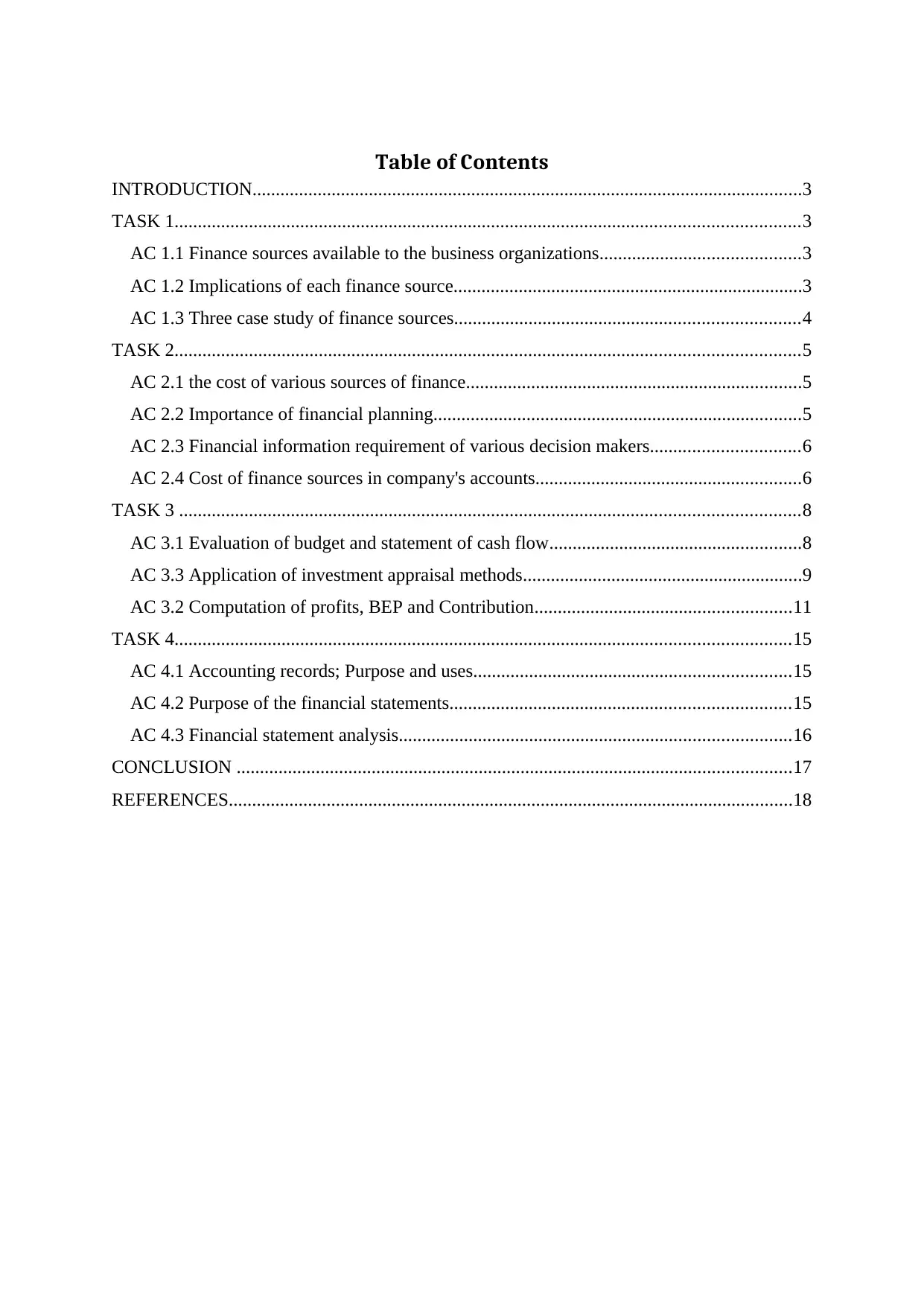
Table of Contents
INTRODUCTION......................................................................................................................3
TASK 1......................................................................................................................................3
AC 1.1 Finance sources available to the business organizations...........................................3
AC 1.2 Implications of each finance source...........................................................................3
AC 1.3 Three case study of finance sources..........................................................................4
TASK 2......................................................................................................................................5
AC 2.1 the cost of various sources of finance........................................................................5
AC 2.2 Importance of financial planning...............................................................................5
AC 2.3 Financial information requirement of various decision makers................................6
AC 2.4 Cost of finance sources in company's accounts.........................................................6
TASK 3 .....................................................................................................................................8
AC 3.1 Evaluation of budget and statement of cash flow......................................................8
AC 3.3 Application of investment appraisal methods............................................................9
AC 3.2 Computation of profits, BEP and Contribution.......................................................11
TASK 4....................................................................................................................................15
AC 4.1 Accounting records; Purpose and uses....................................................................15
AC 4.2 Purpose of the financial statements.........................................................................15
AC 4.3 Financial statement analysis....................................................................................16
CONCLUSION .......................................................................................................................17
REFERENCES.........................................................................................................................18
INTRODUCTION......................................................................................................................3
TASK 1......................................................................................................................................3
AC 1.1 Finance sources available to the business organizations...........................................3
AC 1.2 Implications of each finance source...........................................................................3
AC 1.3 Three case study of finance sources..........................................................................4
TASK 2......................................................................................................................................5
AC 2.1 the cost of various sources of finance........................................................................5
AC 2.2 Importance of financial planning...............................................................................5
AC 2.3 Financial information requirement of various decision makers................................6
AC 2.4 Cost of finance sources in company's accounts.........................................................6
TASK 3 .....................................................................................................................................8
AC 3.1 Evaluation of budget and statement of cash flow......................................................8
AC 3.3 Application of investment appraisal methods............................................................9
AC 3.2 Computation of profits, BEP and Contribution.......................................................11
TASK 4....................................................................................................................................15
AC 4.1 Accounting records; Purpose and uses....................................................................15
AC 4.2 Purpose of the financial statements.........................................................................15
AC 4.3 Financial statement analysis....................................................................................16
CONCLUSION .......................................................................................................................17
REFERENCES.........................................................................................................................18
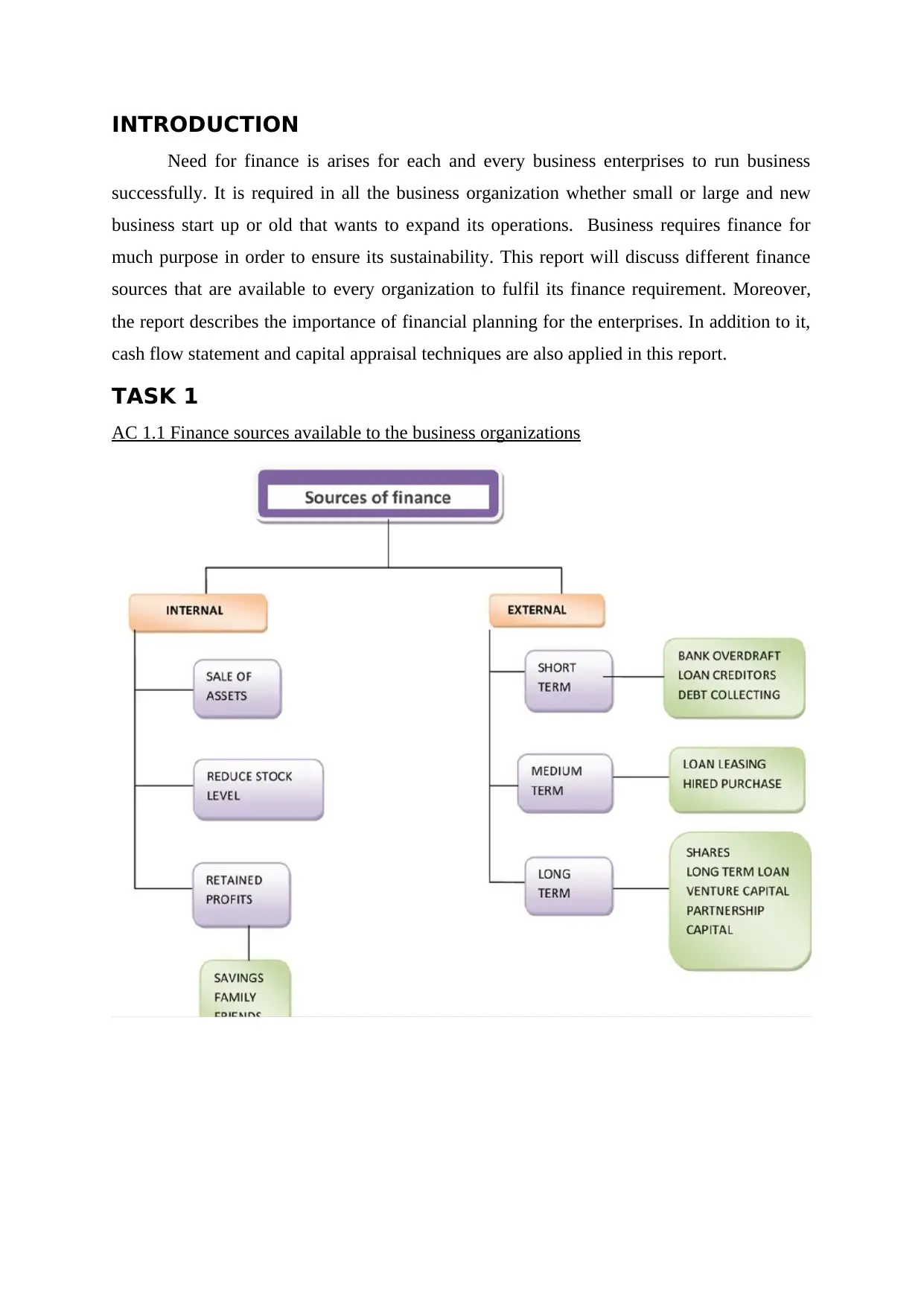
INTRODUCTION
Need for finance is arises for each and every business enterprises to run business
successfully. It is required in all the business organization whether small or large and new
business start up or old that wants to expand its operations. Business requires finance for
much purpose in order to ensure its sustainability. This report will discuss different finance
sources that are available to every organization to fulfil its finance requirement. Moreover,
the report describes the importance of financial planning for the enterprises. In addition to it,
cash flow statement and capital appraisal techniques are also applied in this report.
TASK 1
AC 1.1 Finance sources available to the business organizations
Need for finance is arises for each and every business enterprises to run business
successfully. It is required in all the business organization whether small or large and new
business start up or old that wants to expand its operations. Business requires finance for
much purpose in order to ensure its sustainability. This report will discuss different finance
sources that are available to every organization to fulfil its finance requirement. Moreover,
the report describes the importance of financial planning for the enterprises. In addition to it,
cash flow statement and capital appraisal techniques are also applied in this report.
TASK 1
AC 1.1 Finance sources available to the business organizations
⊘ This is a preview!⊘
Do you want full access?
Subscribe today to unlock all pages.

Trusted by 1+ million students worldwide
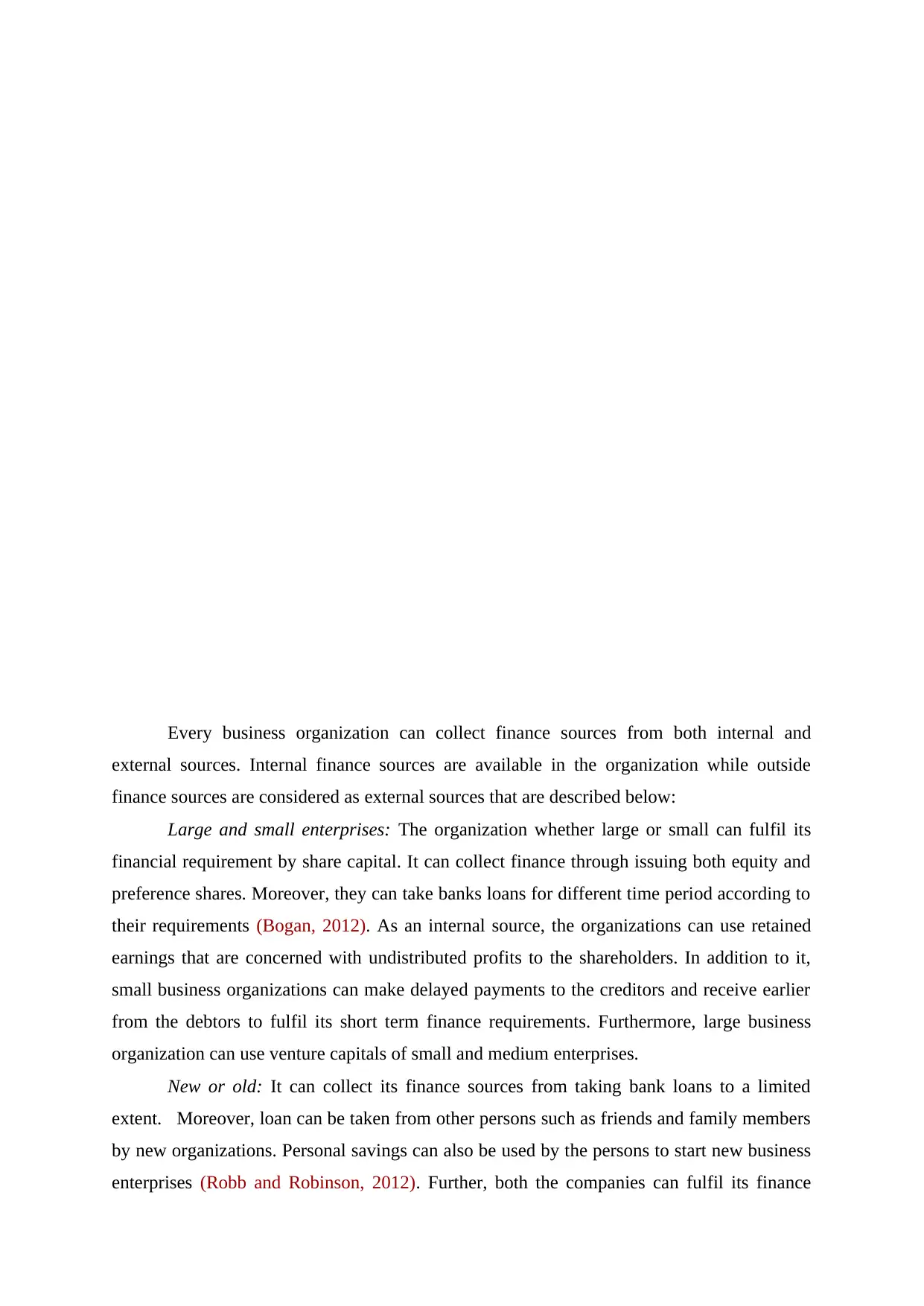
Every business organization can collect finance sources from both internal and
external sources. Internal finance sources are available in the organization while outside
finance sources are considered as external sources that are described below:
Large and small enterprises: The organization whether large or small can fulfil its
financial requirement by share capital. It can collect finance through issuing both equity and
preference shares. Moreover, they can take banks loans for different time period according to
their requirements (Bogan, 2012). As an internal source, the organizations can use retained
earnings that are concerned with undistributed profits to the shareholders. In addition to it,
small business organizations can make delayed payments to the creditors and receive earlier
from the debtors to fulfil its short term finance requirements. Furthermore, large business
organization can use venture capitals of small and medium enterprises.
New or old: It can collect its finance sources from taking bank loans to a limited
extent. Moreover, loan can be taken from other persons such as friends and family members
by new organizations. Personal savings can also be used by the persons to start new business
enterprises (Robb and Robinson, 2012). Further, both the companies can fulfil its finance
external sources. Internal finance sources are available in the organization while outside
finance sources are considered as external sources that are described below:
Large and small enterprises: The organization whether large or small can fulfil its
financial requirement by share capital. It can collect finance through issuing both equity and
preference shares. Moreover, they can take banks loans for different time period according to
their requirements (Bogan, 2012). As an internal source, the organizations can use retained
earnings that are concerned with undistributed profits to the shareholders. In addition to it,
small business organizations can make delayed payments to the creditors and receive earlier
from the debtors to fulfil its short term finance requirements. Furthermore, large business
organization can use venture capitals of small and medium enterprises.
New or old: It can collect its finance sources from taking bank loans to a limited
extent. Moreover, loan can be taken from other persons such as friends and family members
by new organizations. Personal savings can also be used by the persons to start new business
enterprises (Robb and Robinson, 2012). Further, both the companies can fulfil its finance
Paraphrase This Document
Need a fresh take? Get an instant paraphrase of this document with our AI Paraphraser
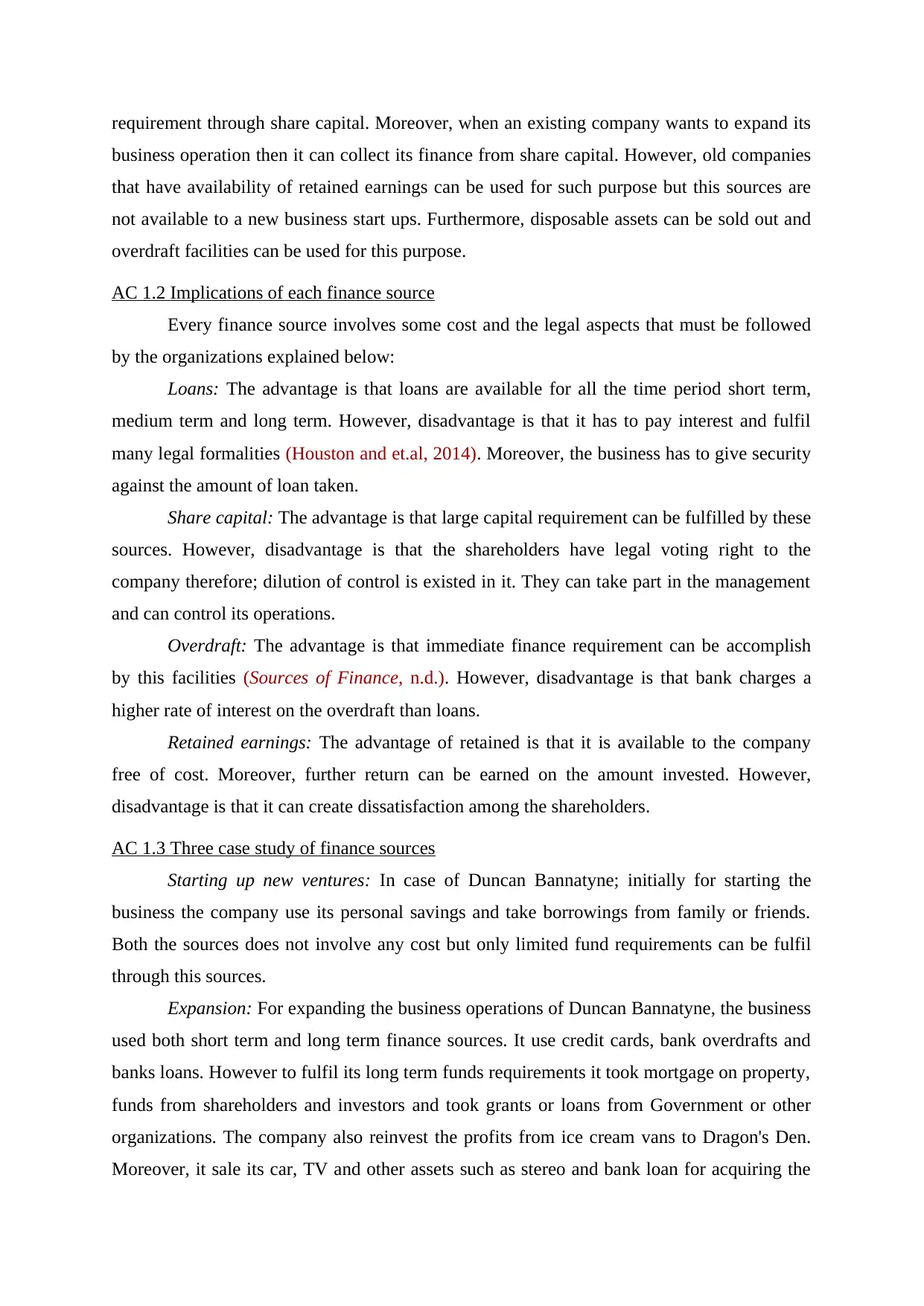
requirement through share capital. Moreover, when an existing company wants to expand its
business operation then it can collect its finance from share capital. However, old companies
that have availability of retained earnings can be used for such purpose but this sources are
not available to a new business start ups. Furthermore, disposable assets can be sold out and
overdraft facilities can be used for this purpose.
AC 1.2 Implications of each finance source
Every finance source involves some cost and the legal aspects that must be followed
by the organizations explained below:
Loans: The advantage is that loans are available for all the time period short term,
medium term and long term. However, disadvantage is that it has to pay interest and fulfil
many legal formalities (Houston and et.al, 2014). Moreover, the business has to give security
against the amount of loan taken.
Share capital: The advantage is that large capital requirement can be fulfilled by these
sources. However, disadvantage is that the shareholders have legal voting right to the
company therefore; dilution of control is existed in it. They can take part in the management
and can control its operations.
Overdraft: The advantage is that immediate finance requirement can be accomplish
by this facilities (Sources of Finance, n.d.). However, disadvantage is that bank charges a
higher rate of interest on the overdraft than loans.
Retained earnings: The advantage of retained is that it is available to the company
free of cost. Moreover, further return can be earned on the amount invested. However,
disadvantage is that it can create dissatisfaction among the shareholders.
AC 1.3 Three case study of finance sources
Starting up new ventures: In case of Duncan Bannatyne; initially for starting the
business the company use its personal savings and take borrowings from family or friends.
Both the sources does not involve any cost but only limited fund requirements can be fulfil
through this sources.
Expansion: For expanding the business operations of Duncan Bannatyne, the business
used both short term and long term finance sources. It use credit cards, bank overdrafts and
banks loans. However to fulfil its long term funds requirements it took mortgage on property,
funds from shareholders and investors and took grants or loans from Government or other
organizations. The company also reinvest the profits from ice cream vans to Dragon's Den.
Moreover, it sale its car, TV and other assets such as stereo and bank loan for acquiring the
business operation then it can collect its finance from share capital. However, old companies
that have availability of retained earnings can be used for such purpose but this sources are
not available to a new business start ups. Furthermore, disposable assets can be sold out and
overdraft facilities can be used for this purpose.
AC 1.2 Implications of each finance source
Every finance source involves some cost and the legal aspects that must be followed
by the organizations explained below:
Loans: The advantage is that loans are available for all the time period short term,
medium term and long term. However, disadvantage is that it has to pay interest and fulfil
many legal formalities (Houston and et.al, 2014). Moreover, the business has to give security
against the amount of loan taken.
Share capital: The advantage is that large capital requirement can be fulfilled by these
sources. However, disadvantage is that the shareholders have legal voting right to the
company therefore; dilution of control is existed in it. They can take part in the management
and can control its operations.
Overdraft: The advantage is that immediate finance requirement can be accomplish
by this facilities (Sources of Finance, n.d.). However, disadvantage is that bank charges a
higher rate of interest on the overdraft than loans.
Retained earnings: The advantage of retained is that it is available to the company
free of cost. Moreover, further return can be earned on the amount invested. However,
disadvantage is that it can create dissatisfaction among the shareholders.
AC 1.3 Three case study of finance sources
Starting up new ventures: In case of Duncan Bannatyne; initially for starting the
business the company use its personal savings and take borrowings from family or friends.
Both the sources does not involve any cost but only limited fund requirements can be fulfil
through this sources.
Expansion: For expanding the business operations of Duncan Bannatyne, the business
used both short term and long term finance sources. It use credit cards, bank overdrafts and
banks loans. However to fulfil its long term funds requirements it took mortgage on property,
funds from shareholders and investors and took grants or loans from Government or other
organizations. The company also reinvest the profits from ice cream vans to Dragon's Den.
Moreover, it sale its car, TV and other assets such as stereo and bank loan for acquiring the
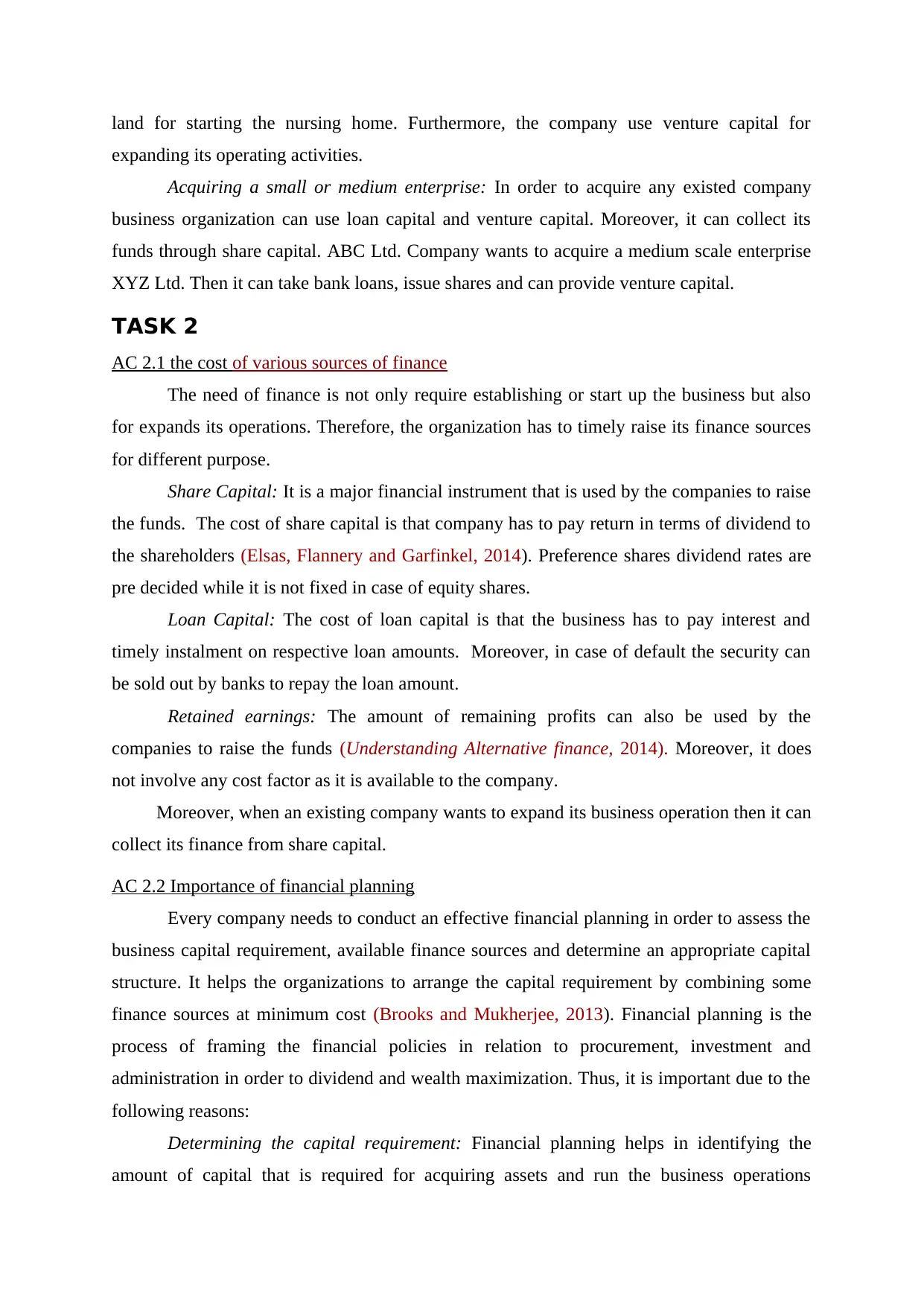
land for starting the nursing home. Furthermore, the company use venture capital for
expanding its operating activities.
Acquiring a small or medium enterprise: In order to acquire any existed company
business organization can use loan capital and venture capital. Moreover, it can collect its
funds through share capital. ABC Ltd. Company wants to acquire a medium scale enterprise
XYZ Ltd. Then it can take bank loans, issue shares and can provide venture capital.
TASK 2
AC 2.1 the cost of various sources of finance
The need of finance is not only require establishing or start up the business but also
for expands its operations. Therefore, the organization has to timely raise its finance sources
for different purpose.
Share Capital: It is a major financial instrument that is used by the companies to raise
the funds. The cost of share capital is that company has to pay return in terms of dividend to
the shareholders (Elsas, Flannery and Garfinkel, 2014). Preference shares dividend rates are
pre decided while it is not fixed in case of equity shares.
Loan Capital: The cost of loan capital is that the business has to pay interest and
timely instalment on respective loan amounts. Moreover, in case of default the security can
be sold out by banks to repay the loan amount.
Retained earnings: The amount of remaining profits can also be used by the
companies to raise the funds (Understanding Alternative finance, 2014). Moreover, it does
not involve any cost factor as it is available to the company.
Moreover, when an existing company wants to expand its business operation then it can
collect its finance from share capital.
AC 2.2 Importance of financial planning
Every company needs to conduct an effective financial planning in order to assess the
business capital requirement, available finance sources and determine an appropriate capital
structure. It helps the organizations to arrange the capital requirement by combining some
finance sources at minimum cost (Brooks and Mukherjee, 2013). Financial planning is the
process of framing the financial policies in relation to procurement, investment and
administration in order to dividend and wealth maximization. Thus, it is important due to the
following reasons:
Determining the capital requirement: Financial planning helps in identifying the
amount of capital that is required for acquiring assets and run the business operations
expanding its operating activities.
Acquiring a small or medium enterprise: In order to acquire any existed company
business organization can use loan capital and venture capital. Moreover, it can collect its
funds through share capital. ABC Ltd. Company wants to acquire a medium scale enterprise
XYZ Ltd. Then it can take bank loans, issue shares and can provide venture capital.
TASK 2
AC 2.1 the cost of various sources of finance
The need of finance is not only require establishing or start up the business but also
for expands its operations. Therefore, the organization has to timely raise its finance sources
for different purpose.
Share Capital: It is a major financial instrument that is used by the companies to raise
the funds. The cost of share capital is that company has to pay return in terms of dividend to
the shareholders (Elsas, Flannery and Garfinkel, 2014). Preference shares dividend rates are
pre decided while it is not fixed in case of equity shares.
Loan Capital: The cost of loan capital is that the business has to pay interest and
timely instalment on respective loan amounts. Moreover, in case of default the security can
be sold out by banks to repay the loan amount.
Retained earnings: The amount of remaining profits can also be used by the
companies to raise the funds (Understanding Alternative finance, 2014). Moreover, it does
not involve any cost factor as it is available to the company.
Moreover, when an existing company wants to expand its business operation then it can
collect its finance from share capital.
AC 2.2 Importance of financial planning
Every company needs to conduct an effective financial planning in order to assess the
business capital requirement, available finance sources and determine an appropriate capital
structure. It helps the organizations to arrange the capital requirement by combining some
finance sources at minimum cost (Brooks and Mukherjee, 2013). Financial planning is the
process of framing the financial policies in relation to procurement, investment and
administration in order to dividend and wealth maximization. Thus, it is important due to the
following reasons:
Determining the capital requirement: Financial planning helps in identifying the
amount of capital that is required for acquiring assets and run the business operations
⊘ This is a preview!⊘
Do you want full access?
Subscribe today to unlock all pages.

Trusted by 1+ million students worldwide
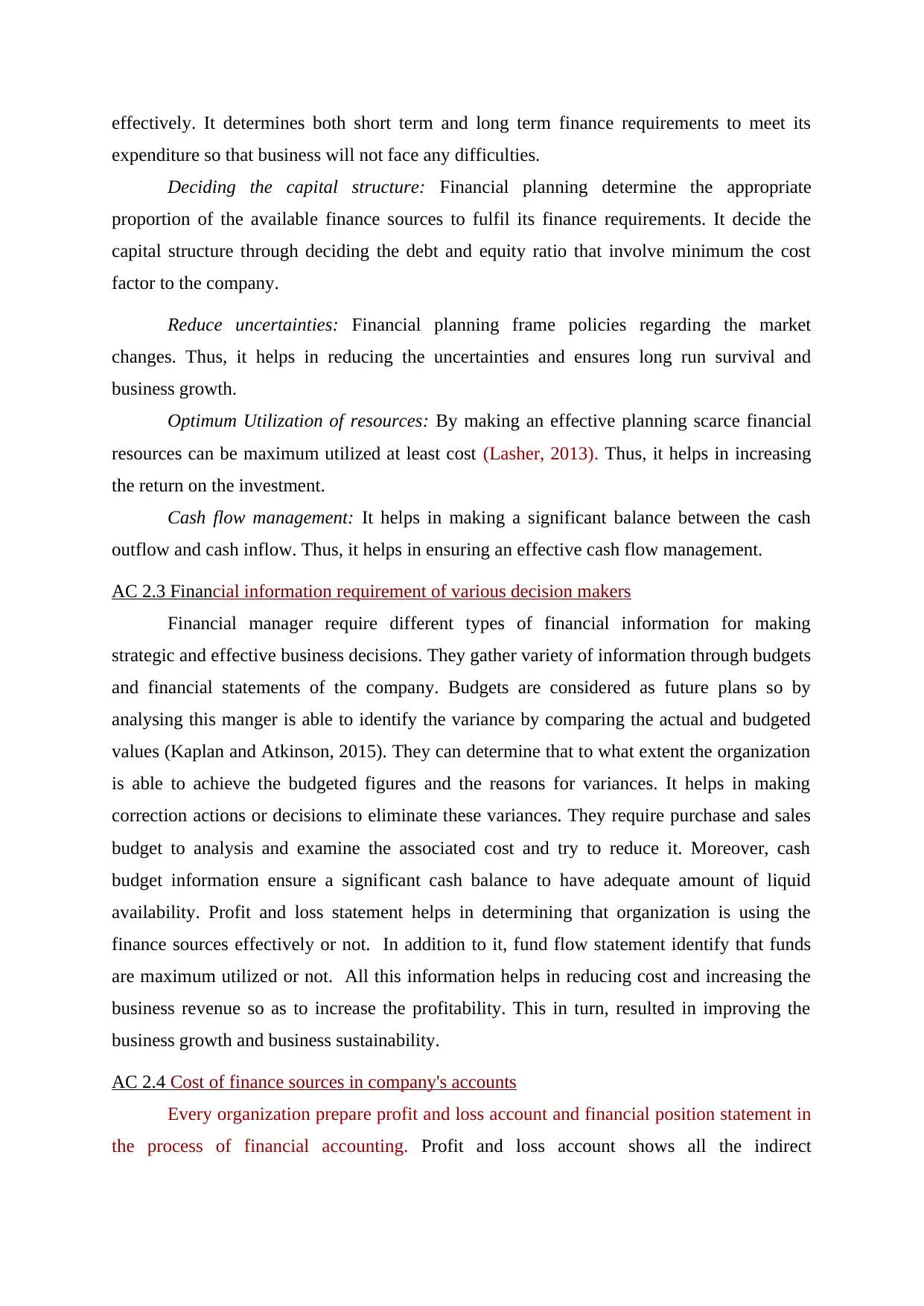
effectively. It determines both short term and long term finance requirements to meet its
expenditure so that business will not face any difficulties.
Deciding the capital structure: Financial planning determine the appropriate
proportion of the available finance sources to fulfil its finance requirements. It decide the
capital structure through deciding the debt and equity ratio that involve minimum the cost
factor to the company.
Reduce uncertainties: Financial planning frame policies regarding the market
changes. Thus, it helps in reducing the uncertainties and ensures long run survival and
business growth.
Optimum Utilization of resources: By making an effective planning scarce financial
resources can be maximum utilized at least cost (Lasher, 2013). Thus, it helps in increasing
the return on the investment.
Cash flow management: It helps in making a significant balance between the cash
outflow and cash inflow. Thus, it helps in ensuring an effective cash flow management.
AC 2.3 Financial information requirement of various decision makers
Financial manager require different types of financial information for making
strategic and effective business decisions. They gather variety of information through budgets
and financial statements of the company. Budgets are considered as future plans so by
analysing this manger is able to identify the variance by comparing the actual and budgeted
values (Kaplan and Atkinson, 2015). They can determine that to what extent the organization
is able to achieve the budgeted figures and the reasons for variances. It helps in making
correction actions or decisions to eliminate these variances. They require purchase and sales
budget to analysis and examine the associated cost and try to reduce it. Moreover, cash
budget information ensure a significant cash balance to have adequate amount of liquid
availability. Profit and loss statement helps in determining that organization is using the
finance sources effectively or not. In addition to it, fund flow statement identify that funds
are maximum utilized or not. All this information helps in reducing cost and increasing the
business revenue so as to increase the profitability. This in turn, resulted in improving the
business growth and business sustainability.
AC 2.4 Cost of finance sources in company's accounts
Every organization prepare profit and loss account and financial position statement in
the process of financial accounting. Profit and loss account shows all the indirect
expenditure so that business will not face any difficulties.
Deciding the capital structure: Financial planning determine the appropriate
proportion of the available finance sources to fulfil its finance requirements. It decide the
capital structure through deciding the debt and equity ratio that involve minimum the cost
factor to the company.
Reduce uncertainties: Financial planning frame policies regarding the market
changes. Thus, it helps in reducing the uncertainties and ensures long run survival and
business growth.
Optimum Utilization of resources: By making an effective planning scarce financial
resources can be maximum utilized at least cost (Lasher, 2013). Thus, it helps in increasing
the return on the investment.
Cash flow management: It helps in making a significant balance between the cash
outflow and cash inflow. Thus, it helps in ensuring an effective cash flow management.
AC 2.3 Financial information requirement of various decision makers
Financial manager require different types of financial information for making
strategic and effective business decisions. They gather variety of information through budgets
and financial statements of the company. Budgets are considered as future plans so by
analysing this manger is able to identify the variance by comparing the actual and budgeted
values (Kaplan and Atkinson, 2015). They can determine that to what extent the organization
is able to achieve the budgeted figures and the reasons for variances. It helps in making
correction actions or decisions to eliminate these variances. They require purchase and sales
budget to analysis and examine the associated cost and try to reduce it. Moreover, cash
budget information ensure a significant cash balance to have adequate amount of liquid
availability. Profit and loss statement helps in determining that organization is using the
finance sources effectively or not. In addition to it, fund flow statement identify that funds
are maximum utilized or not. All this information helps in reducing cost and increasing the
business revenue so as to increase the profitability. This in turn, resulted in improving the
business growth and business sustainability.
AC 2.4 Cost of finance sources in company's accounts
Every organization prepare profit and loss account and financial position statement in
the process of financial accounting. Profit and loss account shows all the indirect
Paraphrase This Document
Need a fresh take? Get an instant paraphrase of this document with our AI Paraphraser

expenditures and revenues. However, balance sheet involves the business assets and
liabilities. The cost of financial instruments is shown in both the statements.
Share Capital: The cost of share capital dividend is shown in debit side of profit and
loss account. However, the amount of share capital is shown in the liability side of B/S.
The table presented here showing the cost of share capital dividend in the debit side of
profit and loss account. The total share capital issued by the company will show in the
liability side of the balance sheet.
Debt funds: The cost of loan capital is the interest payments that are charged by
banks. It shows in the debit side of profit and loss account and loan amount shows in liability
side.
liabilities. The cost of financial instruments is shown in both the statements.
Share Capital: The cost of share capital dividend is shown in debit side of profit and
loss account. However, the amount of share capital is shown in the liability side of B/S.
The table presented here showing the cost of share capital dividend in the debit side of
profit and loss account. The total share capital issued by the company will show in the
liability side of the balance sheet.
Debt funds: The cost of loan capital is the interest payments that are charged by
banks. It shows in the debit side of profit and loss account and loan amount shows in liability
side.
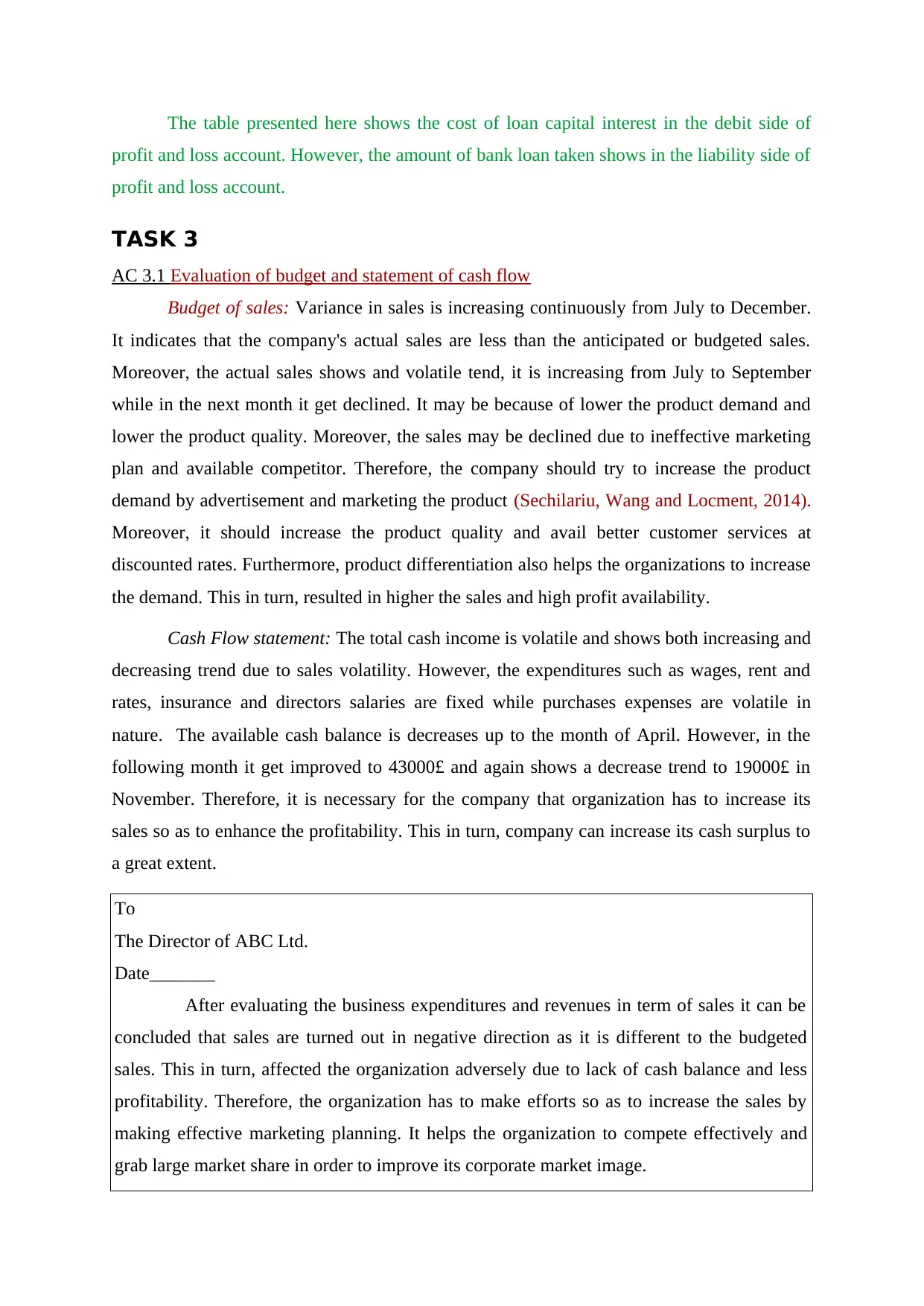
The table presented here shows the cost of loan capital interest in the debit side of
profit and loss account. However, the amount of bank loan taken shows in the liability side of
profit and loss account.
TASK 3
AC 3.1 Evaluation of budget and statement of cash flow
Budget of sales: Variance in sales is increasing continuously from July to December.
It indicates that the company's actual sales are less than the anticipated or budgeted sales.
Moreover, the actual sales shows and volatile tend, it is increasing from July to September
while in the next month it get declined. It may be because of lower the product demand and
lower the product quality. Moreover, the sales may be declined due to ineffective marketing
plan and available competitor. Therefore, the company should try to increase the product
demand by advertisement and marketing the product (Sechilariu, Wang and Locment, 2014).
Moreover, it should increase the product quality and avail better customer services at
discounted rates. Furthermore, product differentiation also helps the organizations to increase
the demand. This in turn, resulted in higher the sales and high profit availability.
Cash Flow statement: The total cash income is volatile and shows both increasing and
decreasing trend due to sales volatility. However, the expenditures such as wages, rent and
rates, insurance and directors salaries are fixed while purchases expenses are volatile in
nature. The available cash balance is decreases up to the month of April. However, in the
following month it get improved to 43000£ and again shows a decrease trend to 19000£ in
November. Therefore, it is necessary for the company that organization has to increase its
sales so as to enhance the profitability. This in turn, company can increase its cash surplus to
a great extent.
To
The Director of ABC Ltd.
Date_______
After evaluating the business expenditures and revenues in term of sales it can be
concluded that sales are turned out in negative direction as it is different to the budgeted
sales. This in turn, affected the organization adversely due to lack of cash balance and less
profitability. Therefore, the organization has to make efforts so as to increase the sales by
making effective marketing planning. It helps the organization to compete effectively and
grab large market share in order to improve its corporate market image.
profit and loss account. However, the amount of bank loan taken shows in the liability side of
profit and loss account.
TASK 3
AC 3.1 Evaluation of budget and statement of cash flow
Budget of sales: Variance in sales is increasing continuously from July to December.
It indicates that the company's actual sales are less than the anticipated or budgeted sales.
Moreover, the actual sales shows and volatile tend, it is increasing from July to September
while in the next month it get declined. It may be because of lower the product demand and
lower the product quality. Moreover, the sales may be declined due to ineffective marketing
plan and available competitor. Therefore, the company should try to increase the product
demand by advertisement and marketing the product (Sechilariu, Wang and Locment, 2014).
Moreover, it should increase the product quality and avail better customer services at
discounted rates. Furthermore, product differentiation also helps the organizations to increase
the demand. This in turn, resulted in higher the sales and high profit availability.
Cash Flow statement: The total cash income is volatile and shows both increasing and
decreasing trend due to sales volatility. However, the expenditures such as wages, rent and
rates, insurance and directors salaries are fixed while purchases expenses are volatile in
nature. The available cash balance is decreases up to the month of April. However, in the
following month it get improved to 43000£ and again shows a decrease trend to 19000£ in
November. Therefore, it is necessary for the company that organization has to increase its
sales so as to enhance the profitability. This in turn, company can increase its cash surplus to
a great extent.
To
The Director of ABC Ltd.
Date_______
After evaluating the business expenditures and revenues in term of sales it can be
concluded that sales are turned out in negative direction as it is different to the budgeted
sales. This in turn, affected the organization adversely due to lack of cash balance and less
profitability. Therefore, the organization has to make efforts so as to increase the sales by
making effective marketing planning. It helps the organization to compete effectively and
grab large market share in order to improve its corporate market image.
⊘ This is a preview!⊘
Do you want full access?
Subscribe today to unlock all pages.

Trusted by 1+ million students worldwide

AC 3.3 Application of investment appraisal methods
Investment appraisal techniques are applied to identify the most suitable project for
the company. As per the given scenario, the ABC Engineering Ltd. have two projects A and
B amounted to 450000£. Project A is concerned with using hi tech machinery while project B
is related to improve the company's marketing activities. A variety of financial tools are
applied to both the projects:
Pay back period: it identify the time period taken by the project to repay the initial
cash outflow.
PP (A) = 2 + (£40000/£280000) = 2.14 yr
PP (B) = 3 year + (£20000/£250000) = 3.08 yr
ARR = (Annual average profit)/ (Average project Investment)*100
A = (£810000/4 yr)/ (£450000)*100 = 45 percentage
(B) = (£680000/4 yr)/ (£450000)*100 = 37.8%
NPV: NPV can be calculated through determining the difference between discounted
cash inflow and cash outflow (Grob, 2013). It is computed here as under:
Investment appraisal techniques are applied to identify the most suitable project for
the company. As per the given scenario, the ABC Engineering Ltd. have two projects A and
B amounted to 450000£. Project A is concerned with using hi tech machinery while project B
is related to improve the company's marketing activities. A variety of financial tools are
applied to both the projects:
Pay back period: it identify the time period taken by the project to repay the initial
cash outflow.
PP (A) = 2 + (£40000/£280000) = 2.14 yr
PP (B) = 3 year + (£20000/£250000) = 3.08 yr
ARR = (Annual average profit)/ (Average project Investment)*100
A = (£810000/4 yr)/ (£450000)*100 = 45 percentage
(B) = (£680000/4 yr)/ (£450000)*100 = 37.8%
NPV: NPV can be calculated through determining the difference between discounted
cash inflow and cash outflow (Grob, 2013). It is computed here as under:
Paraphrase This Document
Need a fresh take? Get an instant paraphrase of this document with our AI Paraphraser

Project A = NPV of A project is 251200£
Project B = NPV of B project is £114130.
Project A = 29.20%
Project B = 15.02%
Recommendation: The payback period of project A is lower than project B to 2.143
year. It implies that project A will take less time than project B to generate initial cash outlay
of 450000£. On Contrary, the accounting rate of return of both the projects is 45% and
37.78%. It indicates that project A is generating higher rate of return so it will be considered
more beneficial for the company. The net present value is calculated by taking cost of capital
to 6%. The net present value of project A and B are 251200£ and £114130. Higher NPV lies
in an investment project. While internal rate of return indicate overall return to 29.20% and
Project B = NPV of B project is £114130.
Project A = 29.20%
Project B = 15.02%
Recommendation: The payback period of project A is lower than project B to 2.143
year. It implies that project A will take less time than project B to generate initial cash outlay
of 450000£. On Contrary, the accounting rate of return of both the projects is 45% and
37.78%. It indicates that project A is generating higher rate of return so it will be considered
more beneficial for the company. The net present value is calculated by taking cost of capital
to 6%. The net present value of project A and B are 251200£ and £114130. Higher NPV lies
in an investment project. While internal rate of return indicate overall return to 29.20% and
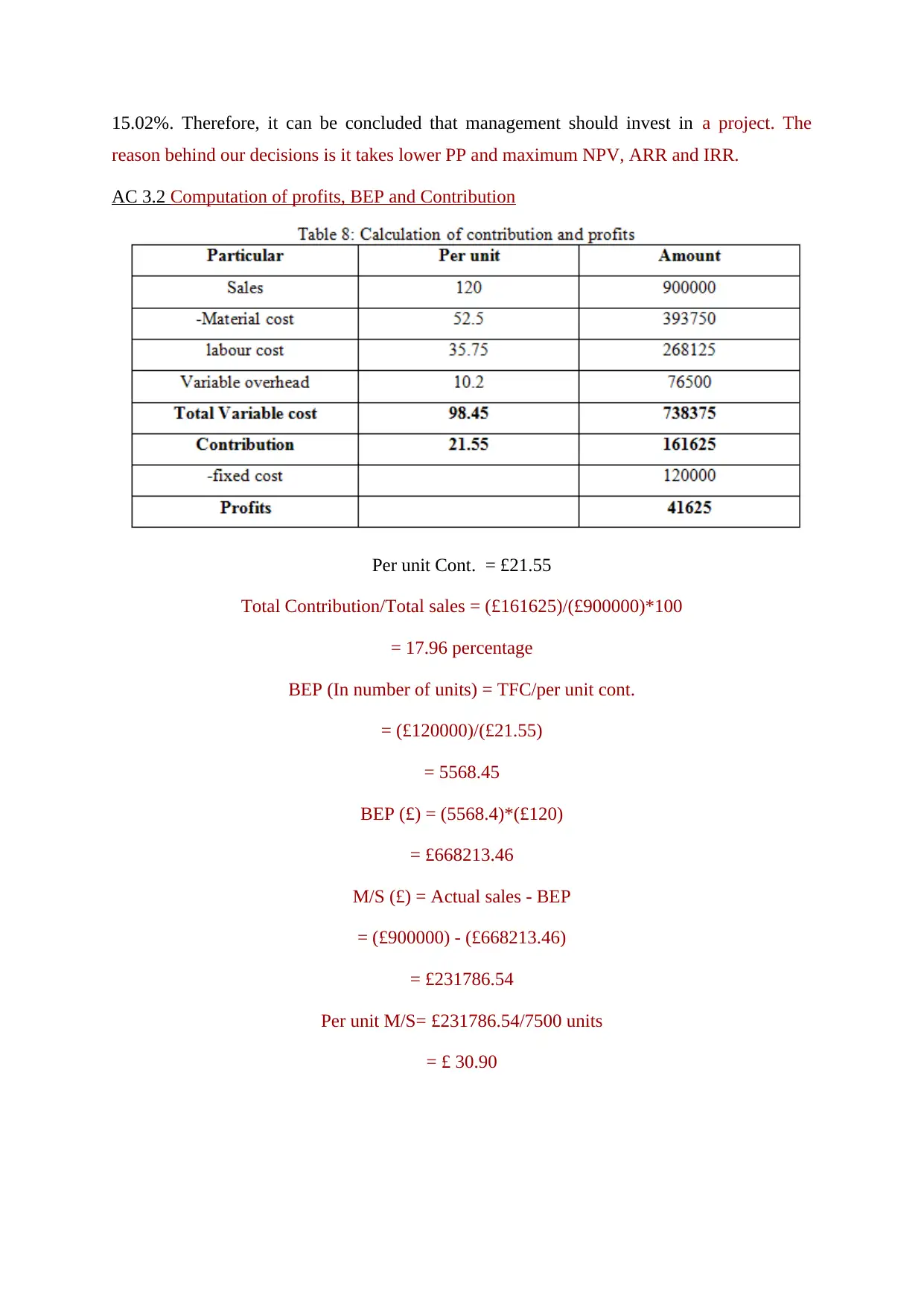
15.02%. Therefore, it can be concluded that management should invest in a project. The
reason behind our decisions is it takes lower PP and maximum NPV, ARR and IRR.
AC 3.2 Computation of profits, BEP and Contribution
Per unit Cont. = £21.55
Total Contribution/Total sales = (£161625)/(£900000)*100
= 17.96 percentage
BEP (In number of units) = TFC/per unit cont.
= (£120000)/(£21.55)
= 5568.45
BEP (£) = (5568.4)*(£120)
= £668213.46
M/S (£) = Actual sales - BEP
= (£900000) - (£668213.46)
= £231786.54
Per unit M/S= £231786.54/7500 units
= £ 30.90
reason behind our decisions is it takes lower PP and maximum NPV, ARR and IRR.
AC 3.2 Computation of profits, BEP and Contribution
Per unit Cont. = £21.55
Total Contribution/Total sales = (£161625)/(£900000)*100
= 17.96 percentage
BEP (In number of units) = TFC/per unit cont.
= (£120000)/(£21.55)
= 5568.45
BEP (£) = (5568.4)*(£120)
= £668213.46
M/S (£) = Actual sales - BEP
= (£900000) - (£668213.46)
= £231786.54
Per unit M/S= £231786.54/7500 units
= £ 30.90
⊘ This is a preview!⊘
Do you want full access?
Subscribe today to unlock all pages.

Trusted by 1+ million students worldwide
1 out of 22
Related Documents
Your All-in-One AI-Powered Toolkit for Academic Success.
+13062052269
info@desklib.com
Available 24*7 on WhatsApp / Email
![[object Object]](/_next/static/media/star-bottom.7253800d.svg)
Unlock your academic potential
Copyright © 2020–2025 A2Z Services. All Rights Reserved. Developed and managed by ZUCOL.





